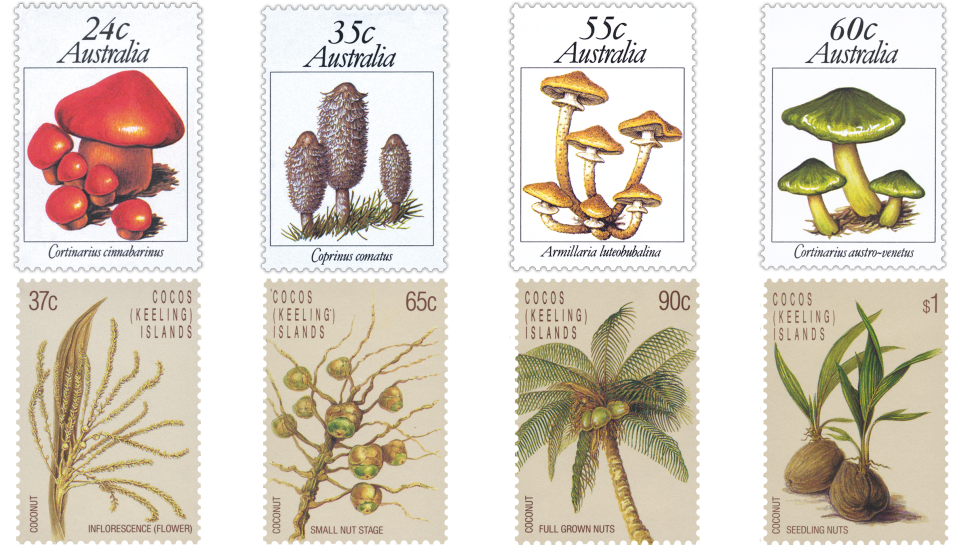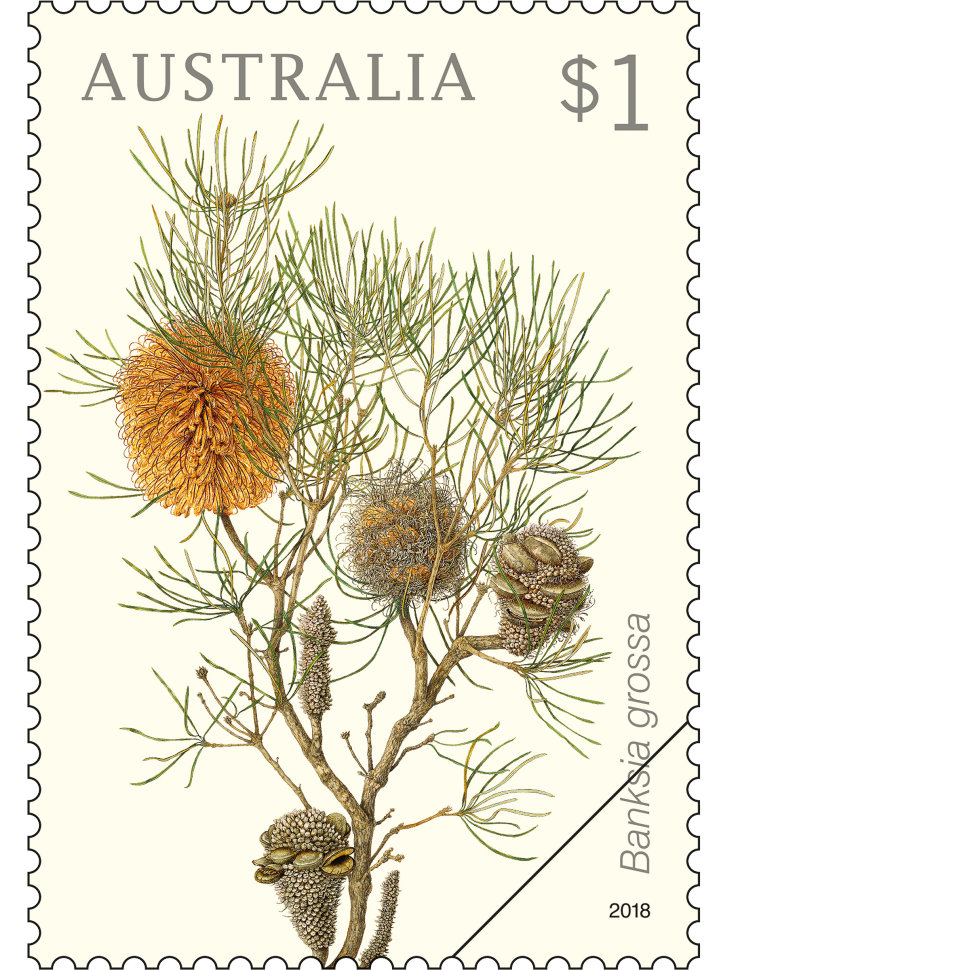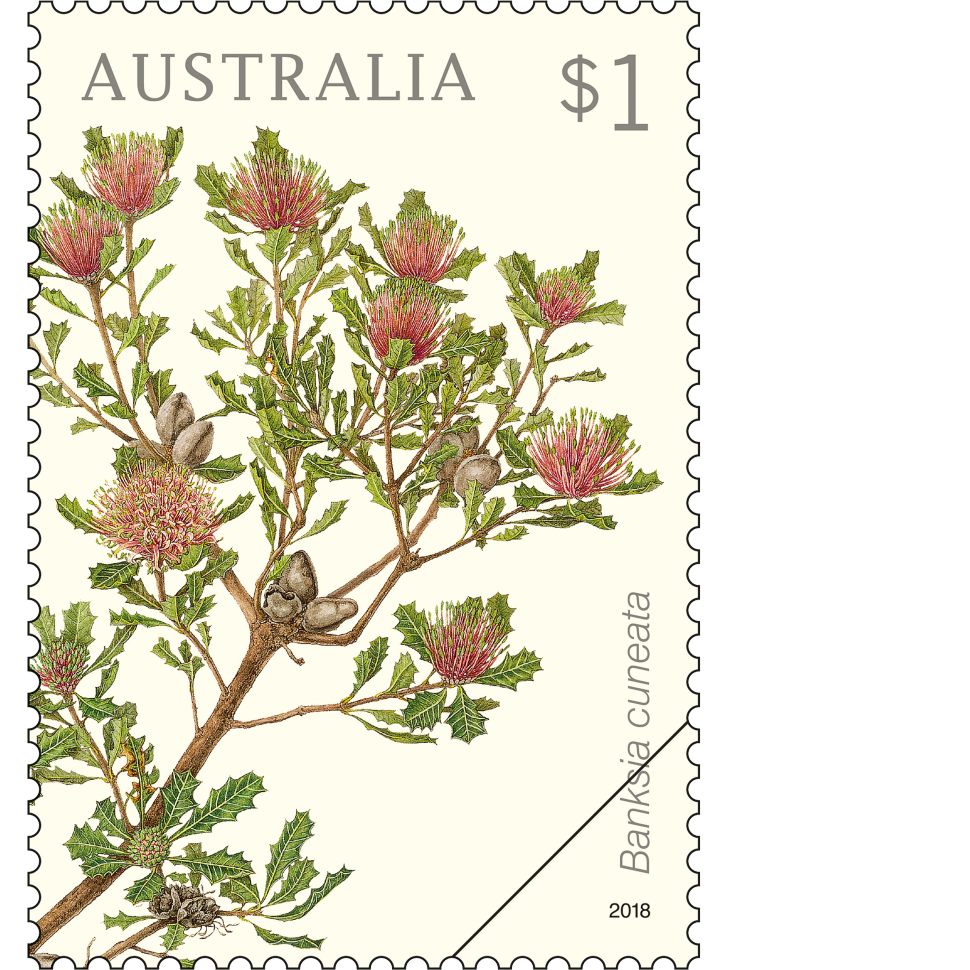Banksias are an evocative native Australian flowering plant; evocative because of the way they instantly conjure up the Australian bush.
Indeed, when Captain James Cook (1728–1729) first voyaged to Botany Bay, in 1768, on the Endeavour, with him was a team of naturalists led by Joseph Banks (1743–1820). Banks and his team collected four species (at that stage, described as “Leucadendrum”). Later, when discussing the difference between the natural environments of Australia and Europe, Banks declared that the Banksia exemplifies this difference more than any other plant species.
The Banksias stamp issue, which will be released on 20 February 2018, celebrates this iconic native flowering plant. The stamps feature the artwork of celebrated Australian botanical artist Celia Rosser. Stamp collectors may already be familiar with Celia’s work, through her incredible illustrations for the 1981 Australian Fungi stamp issue and the 1987 Cocos (Keeling) Islands stamp issue that depicted the life-cycle of the coconut. Celia’s beautiful banksia illustrations also featured on a series on pre-stamped envelopes, in 1996.
Celia Rosser (b. 1930) trained as a fashion illustrator at the Royal Melbourne Institute of Technology, Melbourne but turned her hand to illustrating wildflowers, native orchids and banksias after moving to Orbost, in eastern Victoria. Celia’s reaction to seeing a banksia for the first time was a strong one.
“I was married to a high school teacher, and he got a job at a school in Orbost. When we arrived in Orbost, we made a lovely friend, Brenda Murray. Brenda and I became very good friends, in fact. She could drive, and we would go on little excursions to take our little children to the beach. She saw a track we’d never seen before, leading to the beach at Marlowe. It wasn’t a proper track – it was quick sand. The car sank down to the axle with three children each in the car! Brenda went to find a farmer and a tractor, and I was looking after all the little ones. And that’s when I saw my first banksia, A Banksia serrata … It was the most amazing reaction I’d ever had in my life. ‘That is what I’ve been looking for’, I thought. ‘That was it’,” recalls Celia.
Following her first exhibition in 1965, the National Herbarium of Victoria commissioned her to illustrate the four banksia species collected by Joseph Banks, as part of a publication Wildflowers of Victoria (1967). With her love of banksias kindled, Celia joined the Banksia Project at Monash University, becoming the university’s botanical artist from 1974 to 1999; she worked alongside Australian botanist Alex George on the project and produced scientifically accurate and highly detailed illustrations of all banksia species, which at the time numbered 77. In making her illustrations, Rosser would travel widely to collect specimens from which to paint, observing the details of each species growing in its natural habitat. From pencil sketch to the final colour painting, each artwork would proceed through several stages of rendering and scientific verification before completion.
“They are such a demanding plant to sketch and paint. There are so many varieties, with so many little flowers,” says Celia.
“As a botanical artist, you’ve got to have the ability to see correctly what’s in front of you. Some people, they want to take a photograph, so they are not using their own brain. You need to be able to stand back and look at the plant, to work out to opposites in the spectrum of colours, for example … My dad was a master builder. He taught me to be a ‘looker’,” says Celia.
A key result of the 25-year project is a three volume publication of her outstanding, life-sized artworks titled The Banksias. All three volumes were presented to Her Majesty Queen Elizabeth II, as gifts from the Australian government during three separate visits to Australia.
“I’ve met with the Queen three times,” says Celia. “She took a lot of notice of the work and how I’d done it. I wasn’t at the presentation ceremony for the third volume, but when I did meet the Queen afterwards, she came over to me and took my hand and said, ‘I was so disappointed you weren’t there when I received the book’. She was lovely,” says Celia.
Rosser was awarded an OAM for her services to botanical art, in 1995, as well as the Linnean Society of London’s Jill Smythies Award for Botanical Art. Pre-eminent British botanist William Stern has declared her banksia paintings “the finest botanical illustrations produced in Australia by an Australian”. For her exacting work, Rosser earned an honorary Master of Science in 1981 and an honorary PhD in 1999 from Monash University. Today, she is owner and artist-in-residence at the Celia Rosser Gallery, at Fish Creek, in Victoria’s South Gippsland.
“I didn’t realise I had the ability I ended up with. When I answered Monash University’s advertisement in the newspaper for a ‘faculty artist in science’, blow me down I got the job! … Initially they gave me graphs to draw, so I was rather insulted. But one day, a couple of doctors turned up, including the fantastic Dr George Scott (co-author of Mosses of Southern Australia), who soon realised I had other abilities,” says Celia.
Banksia speciosa
Banksia speciosa (meaning “showy” in Latin) occurs naturally on the south coast of Western Australia, between east Mt Barren to Point Culver. It prefers a habitat of consolidated white-sand dunes, sandplains and tall shrubland. This shrub, which has striking, long, triangular-lobed leaves, can reach eight metres in height. Its cream to pale yellow flowers appear throughout the year, though most prolifically in summer and autumn.
Banksia grossa
This small, slow-growing shrub was first described as recently as 1981, by banksia specialist Alex George. It grows to around one metre in height and its name refers to its clustered coarse, linear leaves on its short branches. Its flowers are rust to golden-brown in colour, with styles of dark red to purple, and it blooms from March to September. The natural occurrence of this fire-resistant species is limited to around Eneabba and Regans Ford, north of Perth, where it prefers a habitat of shallow grey/white sand over laterite, in shrubland.
Banksia coccinea
Banksia coccinea is a striking species, with its bright red flower heads highlighted by its grey-green oblong foliage. Its grey individual flowers are offset by scarlet styles, and it blooms from June through January. Growing to around eight metres, it occurs naturally from Albany to Esperance in Western Australia, preferring a habitat of deep white/grey sand in tall shrubland or low woodland.
Banksia cuneata
Like B. grossa, this species was also first described by Australian botanist and banksia specialist Alex George, this species being described in 1971. It has two common names: Matchstick Banksia for its flowers, and Quairading Banksia for the place it was discovered. It is listed “endangered” on the IUCN Red List and the Environment Protection and Biodiversity Conservation Act 1999, with less than 2500 mature trees evident in the wild. This smooth-barked shrub grows to a height of around four metres. The flower heads are three to four centimetres wide, with styles that are cream turning pink, with a green pollen presenter, and it blooms from September to December. It occurs around Quairading, Brookton and Cuballing, in Western Australia.
Perhaps unsurprisingly, Celia Rosser does have banksias in her own garden, though not as many as she’d like because the soil isn’t the right type.
“I have integrafolia in front of the window and the serrata is growing really well, too,” Celia says.
“I actually have a banksia named in my honour. It’s perfectly round and there are only two perfectly round species. Someone came into the gallery one day and brought in a specimen that had been cut and divided and joined into a new species. It’s called Banksia rosserae. When a species has an ‘ae’ at the end, it’s feminine, “ii” is masculine. There are only two feminine species, mine and Banksia victoriae, named for Queen Victoria.”
Banksia royalty, indeed.
View the Celia Rosser Gallery website.
The artworks featured on the stamps are from the Monash University Collection and appear courtesy of the Monash University Museum of Art.
The Banksias stamp issue is available from 20 February 2018, online, at participating Post Offices and via mail order on 1800 331 794, while stocks last.
View the gallery and technical details from this issue
This article was produced at the time of publication and will not be updated.






